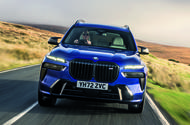Facelift brings more power and aesthetic updates to large and luxurious SUV
BMW increasing the power output of the straight-six diesel in the X7 (badged xDrive40d) from 335bhp to 347bhp might sound about as necessary as nicking your friend’s last chip when you’ve just ordered a super-size Mac Whopper meal.
However, the point was not making this humongous SUV a microsecond faster to 62mph but reducing its consumption, that extra 12bhp coming from a new mild-hybrid system – a crankshaft-mounted starter-generator on the eight-speed automatic gearbox, with a small battery to hold its charge.
This comes as part of the mid-life facelift for the largest BMW – or rather, what was the largest BMW until the arrival of the XM. Compared with that overwrought monster, this seven-seater, which focuses much more on refined luxury than aggressive sportiness, looks almost shy and retiring.
That’s despite it having something of a killer-robot stare, the result of the front light clusters being split as part of a fairly significant redesign. So yes, the most notable element of a BMW design is not, for once, on grilles that make a commercial wok look small – albeit maybe only because the X7 has had those since day one…
As ever, the effect of this is a matter of personal opinion, but there’s no denying that it matches the visual attitude of the M Sport specification that most will order (the alternative is the Excellence, which thankfully isn’t inappropriately named).
Diesel and performance don’t automatically go together in many minds, but my goodness, the X7 xDrive40d pulls like Casanova. Call for it all on a motorway slip road and a relentless flow of torque takes you to 62mph in 5.9sec. In a seven-seat, 5.2-metre-long, 2490kg brick. Thank you very much, 516lb ft of torque – more than in a Ferrari Enzo – from a lowly 1750rpm.
Even more powerful engines are available in the X7: the ‘B58’ turbo petrol straight six, with 375bhp, up 50bhp thanks to the same 48V measure, badged xDrive40i; and a 4.4-litre twin-turbo petrol V8, still with 523bhp but in new MHEV form now called the M60i (not M50i) xDrive. Surely nobody could truly need more power than this, though? Furthermore, the petrols will be less economical than this diesel, which itself only reaches the mid-30s in terms of MPG, officially and in practice, even if you don’t hold back.
The ‘B57’ also doesn’t sound like a diesel – no clattering or gravelly loudness – and is smooth as marble in its delivery, meaning the only real argument against is future-proofing, what with ULEZs and more.
The smoothness and refinement of the engine really matches the character of the rest of the X7, which is just so comfortable and laid-back, despite this one being an M Sport. Even with 21in wheels on thin-walled tyres, the ride disappoints in neither the primary nor the secondary sense. It’s just all-out comfort, all of the time. Only the roar of its run-flats over coarse surfaces irks.
Meanwhile, the chassis feels as if it had limits beyond what was appropriate to try in such a massive machine in green England. I mean that mostly due to its great width, rather than concerns about stopping, because it has supermini-wheel-sized brake discs grabbed by fist-like calipers.
The directness and sharpness of the steering still surprises – but not as much as how small the car feels once you’ve walked the mile around it and jumped up into the driver’s seat. Far from the bus I assumed it would feel like, it shrinks around you to feel just like a longer and taller 3 Series. It really is quite remarkable, and not something that you would feel in many similarly sizeable SUVs. (The sensation also continues during parking, due to the veritable army of sensors, cameras and graphics at your disposal.)
This is despite the fact that the driving position is very roomy – you would have to be big for a Dutchman to complain about either your head or legs – and seemingly in a different lane from your front passenger. The seats themselves are very comfortable, as they should be, given they have many degrees of electronic adjustment and massaging functions.
Not that I realised the latter fact for a while, as the 14.9in infotainment touchscreen – housed within a single curved span alongside the 12.3in digital instrument display – is verging on information overload. Most people have fewer apps on their iPads, honestly. Don’t read the manual and you could still be finding new features after years of ownership.
Whether that’s a criticism depends largely on your perceptions of luxury. What I wanted was mostly easy – sat-nav, Apple CarPlay, DAB radio – or, in the case of trying to add a new phone, bewildering. Changing the ambient lighting was easy, too: I chose Flamingo mode, with even LED elements in the sunroof contributing to an awesome synthwave night vibe.
It goes without saying that the X7 is comfortable for rear passengers too, and shorter adults wouldn’t feel too aggrieved about having to sit in the (otherwise very large indeed) boot.
I expected to dislike the X7 for embodying the needless excess of large SUVs or find it cumbersome and unpleasant to drive. In the end, neither assumption was correct. The lower 7 Series limousine is probably still the better luxury car in outright terms, but it doesn’t offer the outstanding practicality of the X7. And there’s no reason why the diesel should lose its status as the best-selling variant thereof – not in and of itself, anyway.
Source: Autocar
